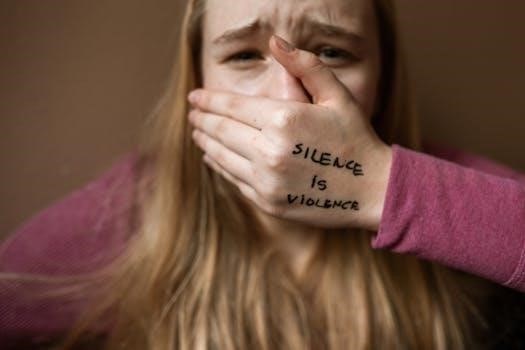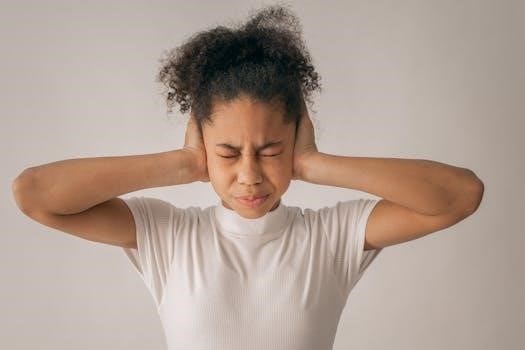Liebowitz Social Anxiety Scale (LSAS)⁚ An Overview
The Liebowitz Social Anxiety Scale (LSAS) is a widely used, 24-item questionnaire designed to assess the extent of fear and avoidance experienced in various social interaction and performance situations. It helps clinicians and researchers measure the severity of social anxiety in individuals.
Purpose of the LSAS
The primary purpose of the Liebowitz Social Anxiety Scale (LSAS) is to provide a standardized and quantifiable measure of social anxiety. This allows clinicians to accurately assess the severity of an individual’s social anxiety symptoms, aiding in diagnosis and treatment planning. The LSAS evaluates both the fear and avoidance components of social anxiety across a range of social and performance situations, offering a comprehensive understanding of the individual’s experience.
Furthermore, the LSAS serves as a valuable tool for researchers investigating social anxiety. Its psychometric properties, including reliability and validity, have been extensively studied, making it a reliable instrument for research purposes. The scale can be used to examine the effectiveness of different treatments for social anxiety, as well as to explore the underlying mechanisms of the disorder.
The LSAS can also track changes in social anxiety symptoms over time, enabling clinicians and researchers to monitor treatment progress or the natural course of the condition. By providing a numerical score, the LSAS allows for objective comparisons between individuals and within individuals at different points in time. Overall, the LSAS is a versatile tool with significant clinical and research applications.

LSAS Versions⁚ Clinician-Administered vs. Self-Report (LSAS-SR)
The Liebowitz Social Anxiety Scale (LSAS) exists in two primary versions⁚ the clinician-administered version and the self-report version, known as the LSAS-SR. The clinician-administered version is typically conducted through an interview, where a trained professional guides the individual through each item, clarifying any uncertainties and ensuring accurate responses. This format allows for a more in-depth assessment and provides an opportunity for the clinician to observe the individual’s behavior and emotional responses during the process.
The LSAS-SR, on the other hand, is a self-administered questionnaire that individuals complete independently. This version is more convenient and time-efficient, making it suitable for large-scale studies or routine screening in clinical settings. While the self-report format may be subject to response biases, such as social desirability, it offers valuable insights into the individual’s subjective experience of social anxiety.
Both versions of the LSAS have demonstrated good psychometric properties, and research suggests that they are generally comparable in terms of their ability to assess social anxiety. The choice between the two versions depends on the specific goals of the assessment and the available resources.
LSAS Scoring and Interpretation
The Liebowitz Social Anxiety Scale (LSAS) scoring involves summing the ratings for both fear and avoidance across the 24 items. Each item assesses a specific social situation, and respondents rate their level of fear or anxiety (from 0 = none to 3 = severe) and their frequency of avoidance (from 0 = never to 3 = usually avoid) in that situation.
The fear scores are summed to obtain a total fear score, and the avoidance scores are summed to obtain a total avoidance score. These scores can be further combined to calculate a total LSAS score, providing an overall measure of social anxiety severity. The total LSAS score is calculated by summing the fear and avoidance scores. Higher scores indicate greater social anxiety.
Interpretation of LSAS scores typically involves comparing the individual’s scores to established cutoff points or normative data. These cutoff points can help categorize individuals into different levels of social anxiety severity, such as mild, moderate, or severe. Clinical interpretation should consider the individual’s specific context, history, and other relevant factors.
It’s important to note that the LSAS is a tool for assessment and should be used in conjunction with clinical judgment to make diagnostic and treatment decisions.

LSAS Reliability and Validity
The Liebowitz Social Anxiety Scale (LSAS) has demonstrated strong reliability and validity across various studies and populations, establishing it as a robust measure of social anxiety. Internal consistency, a measure of how well the items on the scale measure the same construct, has been found to be excellent for both the total LSAS score and its subscales (fear and avoidance).
Test-retest reliability, which assesses the stability of scores over time, has also been shown to be good, indicating that the LSAS provides consistent results when administered to the same individuals at different time points. In terms of validity, the LSAS has demonstrated strong convergent validity, correlating highly with other measures of social anxiety, such as the Social Phobia Scale (SPS) and the Social Interaction Anxiety Scale (SIAS).
Discriminant validity, the ability of the LSAS to distinguish between individuals with and without social anxiety, has also been supported. Furthermore, the LSAS has shown sensitivity to treatment effects, meaning that it can detect changes in social anxiety symptoms following interventions.
These findings collectively support the LSAS as a reliable and valid tool for assessing social anxiety in both clinical and research settings.

LSAS in Different Populations and Languages
The LSAS has been adapted and validated for use in diverse populations and languages, including French and Indonesian. Studies have examined its psychometric properties in African American samples, demonstrating its broad applicability in assessing social anxiety across cultural contexts.
LSAS in African American Samples
Research has specifically addressed the psychometric properties of the Liebowitz Social Anxiety Scale (LSAS) within African American populations, acknowledging the importance of cultural context in mental health assessment. One study, involving 97 participants, explored the LSAS characteristics in this specific demographic, aiming to determine its reliability and validity.
This is crucial because the manifestation and experience of social anxiety can be influenced by cultural norms and societal factors. Therefore, ensuring that assessment tools are appropriate and accurate across diverse groups is essential for effective diagnosis and treatment planning.
The investigations into the LSAS within African American samples contribute to a more comprehensive understanding of social anxiety and its assessment in diverse populations, potentially informing culturally sensitive interventions. The findings from these studies help to bridge the gap in understanding and ensure equitable mental health services for all individuals, regardless of their racial or ethnic background, by validating the LSAS for use in this group.
LSAS in Indonesia (LSAS-SR-Indonesia)
The Liebowitz Social Anxiety Scale-Self Report (LSAS-SR) has been adapted and validated for use in Indonesia, resulting in the LSAS-SR-Indonesia version. Studies have focused on examining the psychometric properties of this Indonesian adaptation to ensure its reliability and validity within the Indonesian cultural context. This adaptation addresses the need for culturally relevant assessment tools for social anxiety in Indonesia, where cultural norms and values may influence the expression and experience of social anxiety.
Research on the LSAS-SR-Indonesia aims to provide clinicians and researchers with a valid and reliable instrument for assessing social anxiety in Indonesian populations. The psychometric evaluations typically involve examining the scale’s internal consistency, factor structure, and its correlation with other measures of anxiety and social functioning. These studies contribute to the cross-cultural understanding of social anxiety and facilitate accurate diagnosis and effective treatment planning for individuals in Indonesia.
Keywords associated with this adaptation include “Liebowitz social anxiety scale-self report, Psychometric evaluation, Gender, Age, Indonesia, CFA, TKS.”
LSAS in French
The Liebowitz Social Anxiety Scale (LSAS) has been adapted into French to provide a reliable tool for assessing social anxiety within French-speaking populations. This adaptation, often denoted as LSAS-SR-French when referring to the self-report version, ensures that the scale’s content is culturally and linguistically appropriate for individuals in France and other French-speaking regions.
Yao et al. (1999) conducted a study adapting both the clinician-administered LSAS and the self-report LSAS-SR into French. Their findings indicated no significant differences between the two versions, suggesting that both formats are equally effective in measuring social anxiety among French-speaking individuals. This adaptation allows clinicians and researchers to utilize the LSAS in a language that is more accessible and understandable for their French-speaking clients and participants.
The availability of a validated French version of the LSAS enhances the cross-cultural applicability of this widely used measure. It facilitates research on social anxiety across different cultural contexts and improves the accuracy of clinical assessments for French-speaking individuals experiencing social anxiety symptoms.
LSAS and Social Phobia Assessment
The Liebowitz Social Anxiety Scale (LSAS) plays a crucial role in the comprehensive assessment of social phobia, also known as social anxiety disorder. As a structured instrument, the LSAS effectively quantifies the severity of social anxiety symptoms by evaluating both the fear and avoidance associated with a range of social situations;
The LSAS comprises 24 items that cover various social interactions and performance scenarios. Individuals rate the degree of fear or anxiety they experience in each situation, as well as the frequency of avoidance behaviors. This dual assessment of fear and avoidance provides a detailed profile of an individual’s social anxiety, allowing clinicians to identify specific areas of difficulty and tailor treatment plans accordingly.
The LSAS distinguishes itself by capturing the multifaceted nature of social phobia, encompassing both generalized and specific subtypes. Its ability to differentiate between fear and avoidance behaviors offers valuable insights into the functional impact of social anxiety on an individual’s daily life, making it an indispensable tool in the diagnostic process.
LSAS and Treatment Sensitivity
The Liebowitz Social Anxiety Scale (LSAS) demonstrates significant sensitivity to treatment-related changes, making it a valuable tool for monitoring progress during interventions for social anxiety disorder. Its ability to detect subtle improvements in both fear and avoidance aspects of social anxiety allows clinicians to objectively assess the effectiveness of various therapeutic approaches.
Studies have consistently shown that LSAS scores decrease significantly following successful treatment, whether through cognitive-behavioral therapy (CBT), medication, or a combination of both. The LSAS can be used to track changes throughout the treatment, providing feedback to both the clinician and the patient regarding the effectiveness of the intervention.
The LSAS’s sensitivity extends to differentiating between various treatment modalities, allowing researchers to compare the efficacy of different approaches. This characteristic makes the LSAS an invaluable outcome measure in clinical trials, facilitating the development and refinement of evidence-based treatments for social anxiety disorder, ultimately improving patient outcomes and quality of life.
LSAS Item Examples and Structure
The Liebowitz Social Anxiety Scale (LSAS) comprises 24 items, each describing a specific social interaction or performance situation. These items are carefully structured to assess the range of experiences associated with social anxiety. Each item is rated on two dimensions⁚ fear and avoidance. Respondents rate the level of fear or anxiety they would experience in the situation, as well as how often they would avoid the situation.
Examples of LSAS items include “Telephoning in public,” “Participating in small groups,” and “Eating in public places.” For each situation, individuals rate their anxiety on a scale from 0 (none) to 3 (severe). They also rate their avoidance of the situation on a similar scale from 0 (never) to 3 (usually avoid).
The structure of the LSAS allows for the calculation of subscale scores for fear and avoidance, providing a comprehensive assessment of social anxiety. The LSAS total score reflects the overall severity of social anxiety. This detailed structure provides valuable insights into the specific areas of social anxiety impacting an individual.

LSAS Availability (PDF) and Access
The Liebowitz Social Anxiety Scale (LSAS) is a valuable tool for assessing social anxiety, and access to the instrument is essential for both clinicians and researchers; While the LSAS is not always readily available in the public domain as a free PDF, several avenues exist for obtaining a copy. It’s important to note that due to copyright restrictions, direct downloads of the LSAS PDF might be limited.
Researchers and clinicians can often find the LSAS within research articles or publications that have utilized the scale. These publications may include the LSAS as part of their methodology or appendices. Academic databases and research repositories are excellent resources for locating such articles.
Furthermore, some websites dedicated to mental health resources or assessment tools might provide access to the LSAS, either for free or through a paid subscription. It’s crucial to ensure that any downloaded version is from a reputable source to maintain the integrity of the instrument. Consulting with academic institutions or mental health organizations can also provide guidance on accessing the LSAS PDF.
LSAS Contributors and Development History
The Liebowitz Social Anxiety Scale (LSAS) owes its existence to the dedicated efforts of several contributors, primarily led by Dr. Michael R. Liebowitz. Dr. Liebowitz, a prominent figure in the field of social anxiety research, spearheaded the development of the LSAS in the 1980s. His vision was to create a comprehensive and reliable instrument for assessing the multifaceted nature of social anxiety.
The LSAS, initially known as the Liebowitz Social Phobia Scale (LSPS), emerged from a need for a standardized measure that could effectively capture both the fear and avoidance components of social anxiety. Dr. Liebowitz’s work built upon existing research and clinical observations to identify key social situations that commonly elicit anxiety in individuals with social phobia.
Over time, the LSAS has undergone revisions and adaptations to enhance its psychometric properties and clinical utility. The contributions of other researchers and clinicians have further refined the scale, leading to the development of self-report versions and translations into various languages. The LSAS continues to be a valuable tool in social anxiety research and clinical practice, a testament to the original vision and collaborative efforts of its contributors.


